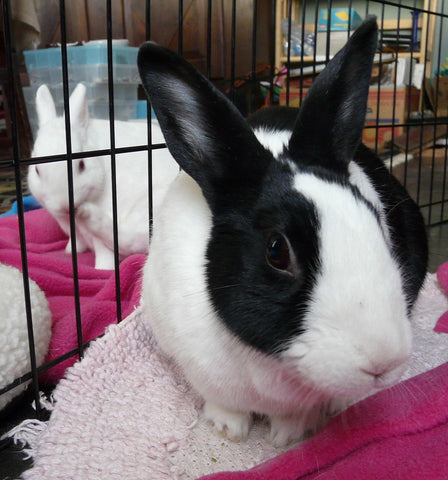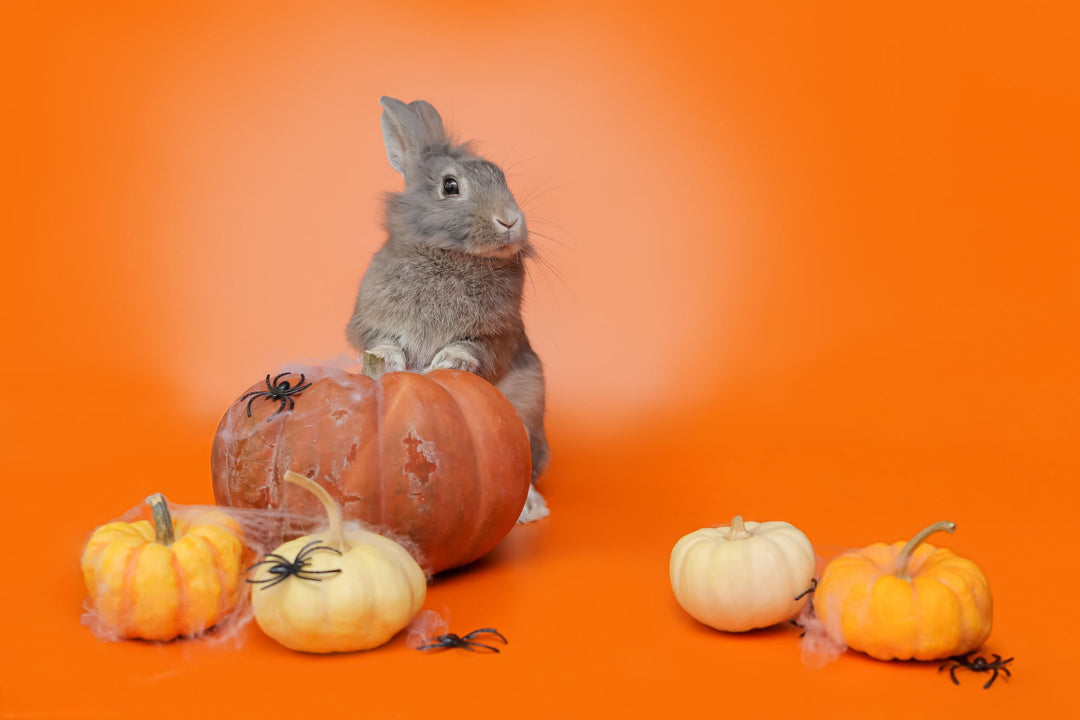Bonding Rabbits
Bonding rabbits
My Dearest reader,
My late father had a saying, “you can learn a lot about a rabbit from the company they keep”. I suppose that’s why he was so keen to avoid being seen with his cousin Peter Rabbit! Whilst my father wasn’t the most affable rabbit in the world, he wasn’t wrong.
Rabbits are very social creatures, so being part of a friendship is more important than you might think. When living with humans, rabbits are happier and live longer when paired with a friend. (RWAF)If you have just the one rabbit, and you’re looking to add another to keep them company, then I have all the information you’ll need to make a great success of it.

What is ‘bonding’?
Bonding is the process of two rabbits gradually becoming friends. Rabbit relationships are very much like human ones; some friendships are instant, some take time, some just don’t work out at all. The bonding process has many steps, and can take some time, but it is crucial to making a friendship form and last. It’s just too risky to throw two rabbits unknown to each other together.
What are the rabbit bonding stages?
There are a few stages so be sure to pay attention!
- Health check: The first stage of bonding is to make sure that your rabbit is physically up to it. If they are old enough, make sure they are neutered (a sore wake up, definitely, but absolutely necessary). It is also important to make sure that all vital signs are normal; are they eating well? Drinking well? Are they physically fit? Be sure to give your rabbit a good check over before any meetings take place. Remember that some diseases like Encephalitizoon cuniculi (EC) can lay dormant in a rabbit, so a thorough health check is essential.
- Preparation: To have the best chance at bonding successfully, it’s important to make sure you have the equipment and the space to do it. You will need separate enclosures, a neutral area/room, and something to help break up fights. Hopefully, you won’t have to deal with the latter, but if you do a dust pan, broom, squirt bottle and gloves will all help to calm the situation.
- Patience: Bonding rabbits can be short process, or a long one. It can take anywhere between two weeks and two months for a bonding pair to become firm, furry friends. So don’t be discouraged if it doesn't happen straight away.
Does gender matter when pairing rabbits?
Such an astute question! Studies have shown (RAWF) that certain pairings between genders are more successful than others. I must reiterate, personality is the defining feature to how successful a pairing will be. So please bear that in mind when conducting a bond.
According to the extensive study, male-female pairings (2396 attempts) had a success rate of 95%. Female-female pairings (391 attempts) had a success rate of 89%, while male-male pairings (382 attempts) had a success rate of 86%.
As you can see from the numbers, rabbits like making friends. Sure, don’t we all? Just remind yourself that once you have bonded a pair of rabbits, you shouldn’t separate them. If you’re going to the vet, be a dear and take them both together in the same carrier. They’ll support one another and give each other the strength to go on. Really, Celine Dion should have written about rabbit love instead of human love!
I have chosen my pairing, their healthy, well and ready to start – what now?
Glad to hear it!
The first step to a successful bond is the introduction stage. You want to give the rabbits time to investigate and learn about one another and, hopefully, think of something clever to say to break the ice.
- Your first step is to let sight and smell do the work. Set up a durable barrier that will stop fights but allows both rabbits to see and smell one another. Rabbits have a very keen sense of smell so getting a whiff of the others cologne is a wonderful way to start boding . To further the process, you can swap litter trays or any blankets/ cloths/ toys that have the scent of the other rabbit.

- Now the second step. Once your rabbits start to get used to each other and show positive signs, you can begin to leave them in each other’s company for short periods. Remember, this must be done in neutral territory and under strict supervision. Be sure to include enough toys and treats to help distract rabbits and lessen any tension. You want to have enough for two rabbits to not feel like they are competing for resources. Otherwise you might be trying to break up a Friday fight night in your house.
- Third step is very important. Take time to relax and congratulate yourself. Have a cup of oolong, go for a walk, whatever you like just treat yourself. You deserve it.
- For the fourth step, persistence is key. Set a daily schedule to let the rabbits interact with one another without the barrier. Naturally, this process is fluid so if you need to separate them and spend more time with a barrier then do so. You’re on their timetable, not your own.
- Step 5, grooming. Like any engaged couple, should things have gone well introductions will gradually turn into mutual grooming. At this point, you’ll be able to leave the rabbits alone and go about your own business.
By this point, your rabbits will have bonded, and the process will be complete. You may notice that one rabbit is asserting more dominance. So long as there is no violence that is totally normal behaviour. Add to the excitement of it all by asking your partner who they think is the most dominant in your relationship.
What sort of behaviour should I look out for when bonding rabbits?
Unfortunately, we rabbits aren’t eloquent when it comes to human speech. We don't have the equipment or inclination for it. So body language is key to understanding what your rabbit wants to communicate. When conducting the bonding process, you must understand what constitutes as good, bad, and neutral behaviour.
Good Behaviour
Good bonding behaviour has already been discussed, but when your rabbits are getting along their behaviour should resemble the end of a Jane Austen novel. Your rabbits will want to always be close, even if a barrier is between them. They seek each other out if they are separated and they will lovingly groom one another too.
Grooming one another involves licking each other, usually around the head and ears to start. This is a BIG sign, as it means that both rabbits feel safe to be vulnerable in company. ‘Mirroring’ is also a positive sign. This means that one rabbit will copy the movements of the other, signalling a bond that they like each other.

Neutral Behaviour
These can be difficult signs because it’s the context that you must watch for. Be sure to keep a close eye in case any of these behaviours escalate into genuine spats. For these behaviours, make sure your bunnies are calm and comfortable. For instance, your bunnies may ignore each other. This isn’t uncommon in new meetings and isn’t a bad sign early on, but if the problem persists you might have a larger issue.
Another neutral behaviour is nipping. You may have seen this behaviour at the pub yourself…This is a light bite and once again not uncommon for rabbits to do. It’s a gentle way for us to communicate ‘leave me alone’ or ‘give me space’. If nipping starts to become more frequent or aggressive, remove both rabbits and re-evaluate your situation.
Are your rabbits chasing each other? Again, not uncommon behaviour. Rabbit relationships have a clear pecking order, and chasing can be a way of seeing which rabbit is the dominant one. Once again, if the aggression escalates and pain is involved then you have to step in and stop it.
Negative behaviour
Negative behaviour is a clear sign that the bonding process is not going well. As I mentioned earlier, a lot of neutral behaviour can be considered bad if there is aggression. But how do rabbits show aggression? We don’t wave a gun or threaten to call a big brother, but we do show aggression with physical signs. An aggressive rabbit will raise their tail, and splay their ears backwards. If you see this, it’s a clear warning sign and should be taken seriously.
If your rabbits start to circle one another, be warned. A fight is incoming. Your rabbits will keep an eye on each other whilst moving in ever-closer circles. This behaviour will end in a fight and the consequences could be fatal so breaking this behaviour up is imperative.
Bonding can be a difficult experience but also a very rewarding one. The best practise is to take it slow, and remember that progress isn’t always linear. You may have to take a break or repeat some steps. However, the above guide will give you a good foundation for preparing yourself and your rabbits for the bonding process. But what is learning without motivation? If you find that you want to encourage good vibes, as well as healthy eating, you’re in the right place. Nibble and Ganw’s range of healthy herbs are the perfect treat to help your rabbits feel good about making friends. You don’t win friends with salad, but you can win friends with our healthy herbs!
https://nibbleandgnaw.com/collections/herbs-rabbit-treats-guinea-pig-treats




